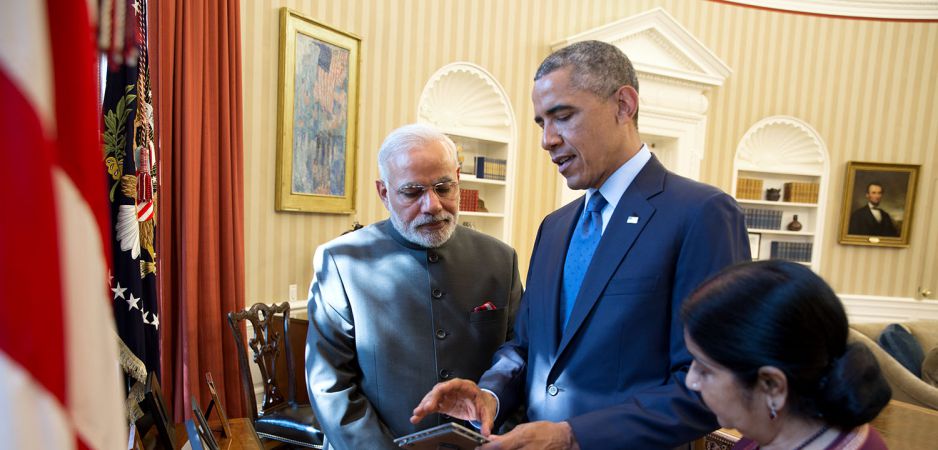India has broken from its reluctance to embrace the US, yet their relationship will not be without its problems.
On December 25, 1991, most Christians from around the world celebrated Christmas to commemorate the birth of Jesus Christ. But on that particular day, many around the globe also celebrated the demise of the Soviet Union (USSR).
Not everyone was pleased that the United States was left as the sole dominant global power. It must have been an especially somber day at the offices of the Non-Aligned Movement (NAM) as the new world would not have the bipolar centers of influence that the movement had hitherto grown accustomed to—therefore, having nothing to be “non-aligned” against.
After the USSR’s dissolution, NAM became a club of nations that was not particularly keen to form a close relationship with Uncle Sam. With its history as a colony of Britain—another erstwhile Western power—and its Nehruvian world view, India was a card-carrying member.
But beneath the icy surface of the US-India relationship, a thaw had already begun. Former Indian Prime Minister Rajiv Gandhi addressed the US Congress in 1984, where he received a standing ovation from American officials. Despite periods of antagonism, more cracks in the ice would later appear, especially at the momentous bilateral event on September 22, 2001, when then-US President George W. Bush lifted nuclear sanctions against India.
Politicians and talking heads in the media were busy negotiating and analyzing the somewhat closer relationship between the clichéd “world’s oldest” and “world’s largest” democracies. Networks between India and the United States continued to grow stronger in the interim years through increased travel; the initial trend was largely driven by the influx of Indian students, which was succeeded by the immigration of Indian software developers into America.
Despite many Indian families having relatives or friends living in the US, and notwithstanding a few pomp-filled presidential and prime ministerial visits that the countries exchanged, Indian governments kept an arm’s length distance from the US. It was almost as if India feared America’s embrace. This sentiment was a result of the strong strain of thought from the far-left and far-right of India’s political spectrum that perceived closer Indo-American ties as geopolitically unwise and unwelcome.
But with Indian Prime Minister Narendra Modi’s election in 2014—and with his Bharatiya Janata Party (BJP) securing a resounding mandate from Indian voters—the tenor of US-India relations changed toward closer and more productive relations.
It is clear that Modi and US President Barack Obama have great respect for each other’s political and personal achievements. Such strong chemistry between the two leaders was fully displayed during their unprecedented mutual visits, which resulted in a raft of business, military, developmental, technological and geostrategic agreements signed between the two nations. There is even talk of boosting annual bilateral trade between the US and India from $100 billion to $500 billion.
But there is no gainsaying that irritants remain. To name just a few, the US dislikes India’s patent/intellectual property, military procurement and foreign investment laws, while India complains about America’s immigration policies and its perceived occasional high-handedness.
A close personal relationship between the two countries’ leaders does not forestall thorny issues from arising between the nations—much less always guarantee mutually satisfactory resolutions—but it does grease the wheels for candid, respectful, reasonable and frequent dialogues. A genuine long-term friendship between India and the US will ensure that the problem du jour of any given moment will not hijack the broader collaboration between the two countries.
India remains a member of NAM, but only in name. In fact, India has decided its interests lie in saying “Namaste” to Uncle Sam.
The views expressed in this article are the author’s own and do not necessarily reflect Fair Observer’s editorial policy.
Photo Credit: Pete Souza
We bring you perspectives from around the world. Help us to inform and educate. Your donation is tax-deductible. Join over 400 people to become a donor or you could choose to be a sponsor.
Support Fair Observer
We rely on your support for our independence, diversity and quality.
For more than 10 years, Fair Observer has been free, fair and independent. No billionaire owns us, no advertisers control us. We are a reader-supported nonprofit. Unlike many other publications, we keep our content free for readers regardless of where they live or whether they can afford to pay. We have no paywalls and no ads.
In the post-truth era of fake news, echo chambers and filter bubbles, we publish a plurality of perspectives from around the world. Anyone can publish with us, but everyone goes through a rigorous editorial process. So, you get fact-checked, well-reasoned content instead of noise.
We publish 2,500+ voices from 90+ countries. We also conduct education and training programs
on subjects ranging from digital media and journalism to writing and critical thinking. This
doesn’t come cheap. Servers, editors, trainers and web developers cost
money.
Please consider supporting us on a regular basis as a recurring donor or a
sustaining member.
Will you support FO’s journalism?
We rely on your support for our independence, diversity and quality.

















Comment